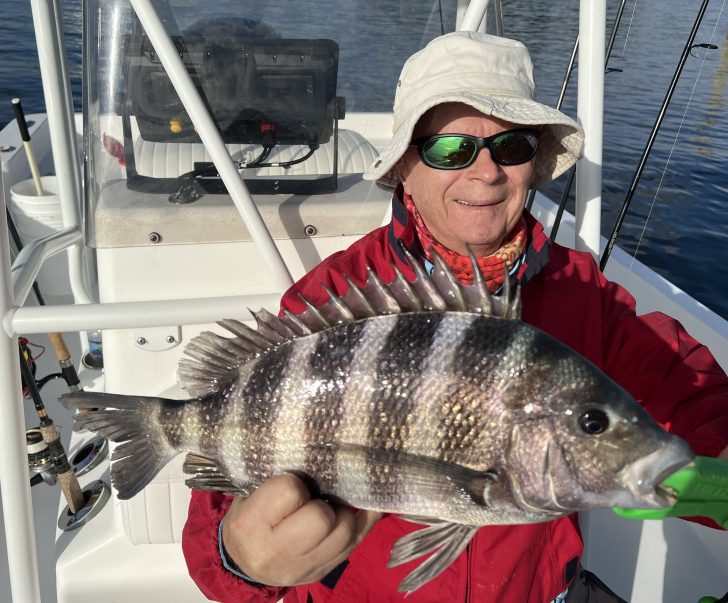February can be one of the best months for sheepshead fishing in the Tampa Bay area. Sheepshead are probably one of the most underrated fish when it comes to table fare, and the fight put up by a larger sheepshead. When fishing deeper water rockpiles for sheepshead, they can be very large and feel as if you are fighting a grouper, with their downward lunges. On the inshore scene, many times, you are sight fishing, and it can take an accurate cast to put the bait where it needs to be, many times under a dock. Then, it is up to you to get them out from between the pilings without getting broken off; so, the challenge is there. There is a real sense of accomplishment when you get a larger sheepshead out from the barnacle encrusted pilings without parting ways. Some areas, depending on water clarity, you cannot use heavy leader to be able to get a bite, and that is when it can get challenging.
Other areas to look for sheepshead are reefs, bridges, ledges, seawalls and any other structures that will hold a food source that they like to eat. They eat barnacles, crabs, worms, oysters, clams, mussels and shrimp, to name a few. They are known to eat small fish, but I wouldn’t use baitfish if I were targeting them. They love crustaceans, so crabs and shrimp would be my first choices, and I have done well using mussels. Sheepshead are known for their incisor human like teeth, but they have, incisors, molars and grinders to be able to eat the barnacles and other crustaceans. Large sheepsheads have the ability to crush the shells of crabs and mussels for example, so keep your fingers out of reach, since they have been known to snap a hook in half.
For the set-up, start with four feet of 25-pound test fluorocarbon leader with a #1 hook. If you are seeing them and not getting bites, first try different baits and then go lighter on the leader. If I am inshore with little to no current, I like to use no weight or as light as possible, like a split shot. In deeper water or current, use a small jig head; or, use a small egg sinker knocker rig, where the leader goes through the egg sinker and the weight slides down to the hook. Sheepshead are bait steelers and they are good at it, so don’t get mad if you miss some. Like an old sheepshead fisherman once told me, “The trick to catching sheepshead is to set the hook right before they bite.” They can have a very subtle bite, so let them put a steady weight on your line. When you feel that steady weight, lift your rod tip and that should do the trick. Once you get the knack for it, you will catch what they call the convict fish. Whether they are named that due to the prison stripes on their body or because they are such good thieves is to be determined.
When it comes to cooking this great tasting fish, I like to dip my sheepshead fillets in an egg batter and then in some Italian style crispy panko breadcrumbs. Then place them in some hot olive oil in a frying pan for a few minutes flip once and cook until it just turns white and flaky.
Another favorite of mine, if you have some thick fillets, is to cut 2-inch medallions out of the fillets and soak them in some Caribbean jerk marinade (or flavor you like) in a zip lock bag for about two hours. The longer the better. Then take them out and place them on a cookie sheet and wrap the outer edge with bacon. Secure the bacon with a toothpick through the center. Now take some fresh marinade and brush them liberally and place the cookie sheet in the oven and bake them at 375 to 400 degrees until the bacon is cooked, approximately 15 to 20 minutes. Flip once at the halfway point. There is never any left.
So, don’t pass up the opportunity to have some fun and enjoy a great meal!

